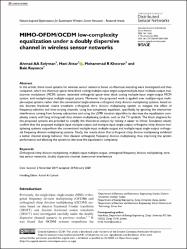| dc.contributor.author | Solyman, Ahmad Amin Ahmad | |
| dc.contributor.author | Attar, Hani | |
| dc.contributor.author | Khosravi, Mohammad R. | |
| dc.contributor.author | Koyuncu, Baki | |
| dc.date.accessioned | 2020-07-19T22:51:10Z | |
| dc.date.available | 2020-07-19T22:51:10Z | |
| dc.date.issued | 2020 | en_US |
| dc.identifier.issn | 1550-1477 | |
| dc.identifier.uri | https://hdl.handle.net/11363/2320 | |
| dc.description.abstract | In this article, three novel systems for wireless sensor networks based on Alamouti decoding were investigated and then compared, which are Alamouti space-time block coding multiple-input single-output/multiple-input multiple-output multicarrier modulation (MCM) system, extended orthogonal space-time block coding multiple-input single-output MCM system, and multiple-input multiple-output system. Moreover, the proposed work is applied over multiple-input multiple-output systems rather than the conventional single-antenna orthogonal chirp division multiplexing systems, based on the discrete fractional cosine transform orthogonal chirp division multiplexing system to mitigate the effect of frequency-selective and time-varying channels, using low-complexity equalizers, specifically by ignoring the intercarrier interference coming from faraway subcarriers and using the LSMR iteration algorithm to decrease the equalization complexity, mainly with long orthogonal chirp division multiplexing symbols, such as the TV symbols. The block diagrams for the proposed systems are provided to simplify the theoretical analysis by making it easier to follow. Simulation results confirm that the proposed multiple-input multiple-output and multiple-input single-output orthogonal chirp division multiplexing systems outperform the conventional multiple-input multiple-output and multiple-input single-output orthogonal frequency division multiplexing systems. Finally, the results show that orthogonal chirp division multiplexing exhibited a better channel energy behavior than classical orthogonal frequency division multiplexing, thus improving the system performance and allowing the system to decrease the equalization complexity. | en_US |
| dc.language.iso | eng | en_US |
| dc.publisher | SAGE PUBLICATIONS INC, 2455 TELLER RD, THOUSAND OAKS, CA 91320 USA | en_US |
| dc.relation.isversionof | 10.1177/1550147720912950 | en_US |
| dc.rights | info:eu-repo/semantics/openAccess | en_US |
| dc.rights | Attribution-NonCommercial-NoDerivs 3.0 United States | * |
| dc.rights.uri | http://creativecommons.org/licenses/by-nc-nd/3.0/us/ | * |
| dc.subject | Orthogonal chirp division multiplexing | en_US |
| dc.subject | multiple-input multiple-output | en_US |
| dc.subject | orthogonal frequency division multiplexing (OFDM) | en_US |
| dc.subject | wireless sensor networks | en_US |
| dc.subject | doubly dispersive channel | en_US |
| dc.subject | intercarrier interference | en_US |
| dc.subject | OFDM | en_US |
| dc.subject | ALGORITHM | en_US |
| dc.subject | SIGNALS | en_US |
| dc.subject | SYSTEM | en_US |
| dc.title | MIMO-OFDM/OCDM low-complexity equalization under a doubly dispersive channel in wireless sensor networks | en_US |
| dc.type | article | en_US |
| dc.relation.ispartof | International Journal of Distributed Sensor Networks | en_US |
| dc.department | Mühendislik ve Mimarlık Fakültesi | en_US |
| dc.identifier.volume | 16 | en_US |
| dc.identifier.issue | 6 | en_US |
| dc.relation.publicationcategory | Makale - Uluslararası Hakemli Dergi - Kurum Öğretim Elemanı | en_US |



















